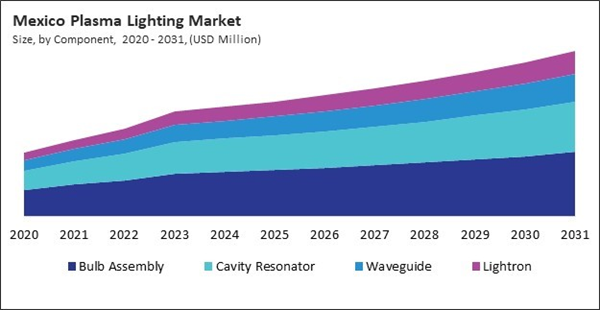The North America Plasma Lighting Market is expected to witness market growth of 4.7% CAGR during the forecast period (2024-2031).
The US market dominated the North America Plasma Lighting Market by Country in 2023, and is expected to continue to be a dominant market till 2031; thereby, achieving a market value of $117.65 millions by 2031. The Canada market is exhibiting a CAGR of 6.8% during 2024-2031. Additionally, the Mexico market would experience a CAGR of 6% during 2024-2031.
Plasma lighting is an advanced lighting technology that produces light using radio frequency or microwave energy to generate plasma, a state of matter in which gas becomes ionized and emits light. Unlike traditional lighting sources, plasma lights do not rely on electrodes or filaments to produce illumination. Instead, the gas within a sealed bulb is energized through electromagnetic waves, which excite the gas particles to create a bright, high-quality light. This lighting technology is known for its high efficiency and long lifespan.
Plasma lighting systems typically consume less electricity than conventional lighting types like incandescent, fluorescent, or even some LED lights while still producing a powerful, bright light output. Plasma lights offer a full spectrum of light, closely resembling natural sunlight. They are suitable for various applications where high color accuracy and brightness are essential, such as horticulture, industrial lighting, street lighting, and certain specialized environments like film studios and art galleries.
Mexico sees increased plasma lighting demand in highways, street lighting, and tunnels. The Mexican government has actively invested in modernizing the country’s infrastructure, focusing on energy-efficient and reliable lighting for public spaces. Plasma lighting, with its high-intensity output and longevity, has been recognized as a valuable solution for enhancing visibility and safety on highways and in tunnels.
Government-backed infrastructure projects, such as the National Infrastructure Program, have bolstered interest in plasma lighting as municipalities aim to reduce maintenance costs while improving public safety across the nation’s expanding road network. Hence, this regional landscape highlights a promising future for plasma lighting, with potential for expansion as awareness and technology improvements continue to evolve.
The US market dominated the North America Plasma Lighting Market by Country in 2023, and is expected to continue to be a dominant market till 2031; thereby, achieving a market value of $117.65 millions by 2031. The Canada market is exhibiting a CAGR of 6.8% during 2024-2031. Additionally, the Mexico market would experience a CAGR of 6% during 2024-2031.
Plasma lighting is an advanced lighting technology that produces light using radio frequency or microwave energy to generate plasma, a state of matter in which gas becomes ionized and emits light. Unlike traditional lighting sources, plasma lights do not rely on electrodes or filaments to produce illumination. Instead, the gas within a sealed bulb is energized through electromagnetic waves, which excite the gas particles to create a bright, high-quality light. This lighting technology is known for its high efficiency and long lifespan.
Plasma lighting systems typically consume less electricity than conventional lighting types like incandescent, fluorescent, or even some LED lights while still producing a powerful, bright light output. Plasma lights offer a full spectrum of light, closely resembling natural sunlight. They are suitable for various applications where high color accuracy and brightness are essential, such as horticulture, industrial lighting, street lighting, and certain specialized environments like film studios and art galleries.
Mexico sees increased plasma lighting demand in highways, street lighting, and tunnels. The Mexican government has actively invested in modernizing the country’s infrastructure, focusing on energy-efficient and reliable lighting for public spaces. Plasma lighting, with its high-intensity output and longevity, has been recognized as a valuable solution for enhancing visibility and safety on highways and in tunnels.
Government-backed infrastructure projects, such as the National Infrastructure Program, have bolstered interest in plasma lighting as municipalities aim to reduce maintenance costs while improving public safety across the nation’s expanding road network. Hence, this regional landscape highlights a promising future for plasma lighting, with potential for expansion as awareness and technology improvements continue to evolve.
List of Key Companies Profiled
- Gavita International B.V.
- BIRNS, Inc.
- Hive Lighting, Inc.
- Pure Plasma Lighting Inc.
- LG Electronics, Inc. (LG Corporation)
- Green de Corp.
- Solaronix SA
- Light Emitting Designs
- Stray Light Optical Technologies
Market Report Segmentation
By Component
- Bulb Assembly
- Cavity Resonator
- Waveguide
- Lightron
By
Wattage
- 300W
- 700W
- 1000W
By Application
- Highways, Street Lighting, & Tunnels
- Industrial
- Sports & Entertainment
- Horticulture
- Other Application
By Country
- US
- Canada
- Mexico
- Rest of North America
Table of Contents
Chapter 1. Market Scope & Methodology
Chapter 2. Market at a Glance
Chapter 3. Market Overview
Chapter 4. North America Plasma Lighting Market by Component
Chapter 5. North America Plasma Lighting Market by Wattage
Chapter 6. North America Plasma Lighting Market by Application
Chapter 7. North America Plasma Lighting Market by Country
Chapter 8. Company Profiles
Companies Mentioned
- Gavita International B.V.
- BIRNS, Inc.
- Hive Lighting, Inc.
- Pure Plasma Lighting Inc.
- LG Electronics, Inc. (LG Corporation)
- Green de Corp.
- Solaronix SA
- Light Emitting Designs
- Stray Light Optical Technologies
Methodology

LOADING...









